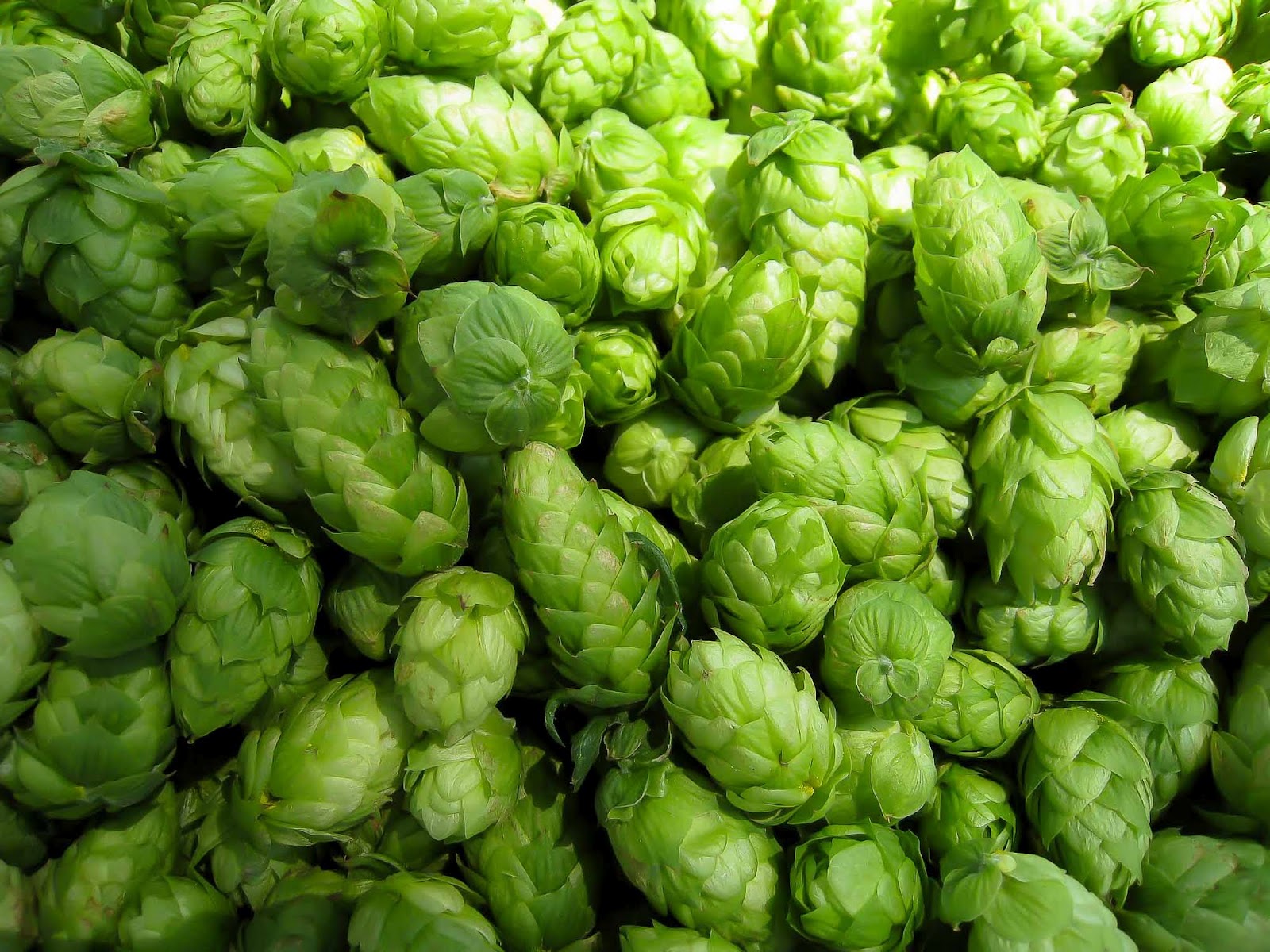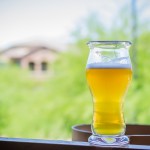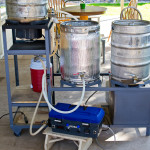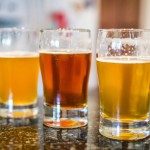Hoppy Beers and Whirlpool Hops

Over the past year I’ve really studied the differences between professional brewers and home brewers. While there are many, one of the big differences in hoppy beers is that pro brewers whirlpool their wort post boil (hot), and home brewers typically do not. Pro brewers often add copious amounts of hops during this time, while it’s rare to see home brewers add hops after flameout, and delay chilling their wort. After thinking about this for awhile, I realized, why not?
Whirlpooling
For brewers that have a pump, whirlpooling post boil is a handy technique. You simply recirculate your wort through a pump, which creates a gentle whirlpool in the kettle. The hop material and trub will all collect in a nice cone in the center of the kettle, and you can draw clear wort into your fermenter. Ignoring that, I realized that a whirlpool is an extended rest for the wort at hot temperatures. Pro brewers whirlpool their wort between 20 and 60 minutes while the wort remains at 200* or higher. This struck me as odd because home brewers try to cool their wort as fast as possible once they turn off the flame.
Whirlpool Hopping
Most home brewers (myself included), add a big hop addition at flameout for hoppy beers, but we then immediately starts chilling our wort. We’ll bring our wort down under 140* in a matter of minutes, and I can’t help but feel we aren’t getting much out of those flameout hops. The belief is that we aren’t driving off any aromatics from the hops, but I feel due to the short contact time at hot temperatures, we aren’t getting much hop aroma or flavor. No one dry hops their beer for only ten minutes, do they?
So when I looked at what pro brewers do, I had a big ‘Ah-ha’ moment. Pro brewers add their ‘flameout’ hops during the whirlpool, and allow them to steep in the whirlpool for 20-60 minutes at 200* or higher. Hrm… this seems drastically different. I found that just about every commercial IPA I love is brewed with lots of whirlpool hops. Now this does introduce some challenges. Alpha acids in hops will still isomerize at temperatures above 170*F; you will be extracting bitterness from the hops. Thankfully these chemical reactions occur slower at cooler temperatures, so hop utilization goes down considerably at 200* compared to 212*. Secondly, wort above 140* will still produce DMS, so you shouldn’t put a lid over the kettle.
Home Brew Whirlpool Hopping
So how did I apply this technique to my brew day? First thing I concluded was that the actual act of whirlpooling isn’t the important part here. If you have the means to create a whirlpool post boil, giddy up. It’s not the important part though. The important thing is to allow the wort to steep for a period of time after you turn off heat, but before turning on the chiller. I settled in on ten minutes. Other than that, it’s pretty simple, add your typical flame out addition of hops, and allow them to steep hot in the wort for your predetermined period of time. Once that time is up, chill your wort as you normally would.
Results
I’ve found my beers have a much more pronounced hop aroma and flavor than before. It seems to be more robust compared to the dry-hop character which can be a bit one-dimensional. I’ve tried this with my Pale Ale, IPA, and DIPA, and all three have had positive results from the ten minute rest after adding the flamout hops. Allowing these hops to steep hot has added some additional bitterness, but that’s easily accounted for by decreasing the 60 or 90 minute hop addition. I’d highly recommend every home brewer try this with their hoppy beers. I won’t even consider going back to my old methods now.
Photo credit: donosborn.com




I have been consider trying this on my hoppy beers. Tasty over on The Brewing Network has been an advocate for the method recently and it sounds promising.
Any reason you chose the 10 minutes? Have tried longer or shorter to see if its is better or worse? How many ounces for a 5 gallon batch are you using too?
Ten minutes was what I tried the first time. It worked, so I decided why go longer; there's diminishing returns at some point (although I'm sure it's longer than ten minutes).
My IPA gets 3oz in the whirlpool, 4pz in my DIPA, and 2oz in my APA. I've noticed much More robust hop aroma in all three.
Fairly new to homebrewing, but I am starting to understand the whole process enough to start to fine tune it, and this interests me a lot.
Couple of (maybe stupid) questions: whole hops or pellets? I prefer pellets because I'm only doing 1 gallon and whole hops suck up too much beer. And you mention the act of whirlpooling isn't as important, so does that just mean give it a good stir at the beginning of the 10 minutes and add the hops?
I almost always use pellets. They store better, and take up less space in the freezer. And ya, just get a good whirlpool going in the kettle, and add the hops, then let them steep for 10 minutes. See if you notice a difference.
"Pro brewers add their 'flameout' hops during the whirlpool, and allow them to steep in the whirlpool for 20-60 minutes at 200* or higher."
Where did you get this information? Sounds like a huge generalization. Don't get me wrong. I have always believed in extended post-boil whirlpool additions. I just don't agree on the temperature of 200 F that you're quoting. As a chef, I know that there are very, very differences between boiling vs. simmering other than the intensity of the bubbling of the liquid and perhaps 5-10 degrees F. So adding the whirlpool hops at 200 F seems to be no different than employing a 1-5 minute boil/simmer addition.
I suggest experimenting with different temperatures. I've found that a quick cool to 150 F, followed by a slow cool down to 65 F with the whirlpool hops helps to hold up the aroma better than a simple flameout addition… or very very hot whirlpool addition.
It is a generalization, but it's a fairly accurate one. Listen to interviews, or talk to brewers. Most breweries whirlpool post boil. Some whirlpool directly in the kettle, and others have a dedicated whirlpool tank. Their purpose for whilpooling is to separate the wort form the trub, but they make no effort to cool the wort down during this process.
Because we're talking about 7bbl to 100bbl systems, there is a much larger thermal inertia to the wort. So while they whirlpool, the wort remains very close to boiling, usually 205-210*.
Yes, I agree there doesn't seem like much difference between 205 and boiling, but isomerization occurs much slower, and hop utilization drops considerably. I've never tried adding hops at 150F, and holding the wort there for a period of time. There very well might be merit in that technique, but I've never tried it.
This article was never intended as the be-all and end-all technique for the best hop aroma. Rather, just a technique that's improved the hop aroma in my beers, and one that's worth trying. Home brewing is all about experimentation.
i ended up doing this with my Pale Ale a few months ago and noticed a huge difference! Thanks for this suggestion
Scott – stumbled upon your blog via google as I am interested in whirlpooling on my new setup – thanks for the great writeup.
Funny to see another hophead brewer/crossfit nut is out there just like me!
Cheers!
You say steep? So you remove them after they sit for the x amount of time in the wort?
Ya. I add all my hops directly to the kettle, then recirculate the pump into a mesh bag. The bag catches the majority of the hops by the time the wort is cooled.
I was looking to see what temps and times other are whirlpooling and found your article. My last IIPA used 10oz hops total – only 1 during the boil, 5 in whirlpool and the remainder in the dry hop addition. That was the best hoppy beer I've ever made and I've done all others the same way ever since.
Hi Scott – just read this. If I was to increase flameout hops from 2oz to 3oz in your blind pig 2.0 recope, what adjustments would you make to the bittering hops in the recipe? Thanks.
I add hops @ 160 and hold/whirlpool for 20 mins or so. This temp seems to get the most out of them. Love me some West Coast IPA!
I’d always believed that as isomerization increases, hop flavour goes down. But I’m not so sure that’s true anymore. It seems like the vigour of a boil may actually be a big contributor to pushing out hop aroma. Steeping hops hot may extract oils quickly from them without much worry about driving off flavour. You’ll get some bitterness too since the temperature is high. More of everything. Just a theory but my experience seems to support it.